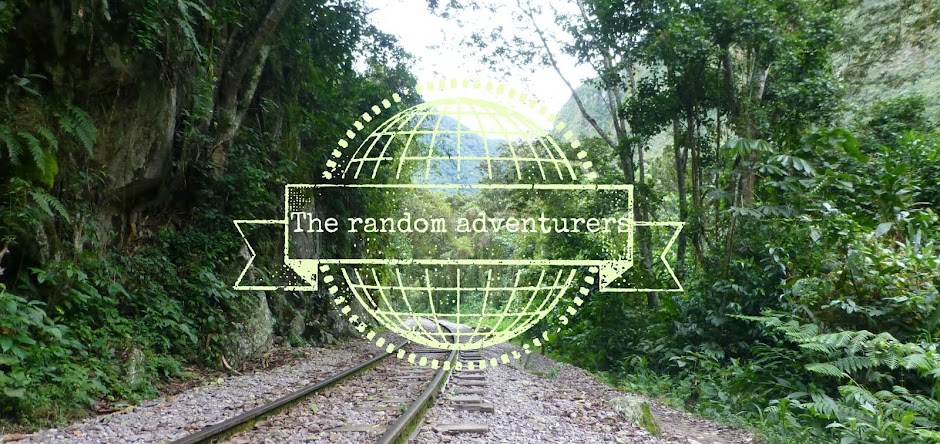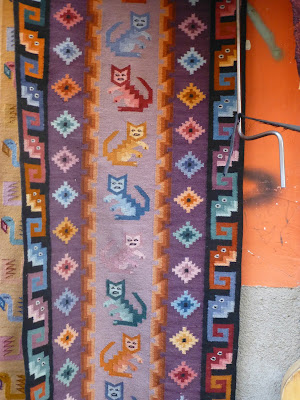The one must-do in La Paz is, indisputably, the famous "Death road".
It has been lovingly nicknamed like that because of the huge amount of people who actually died on it (according to Wikipedia, an estimate of 200 to 300 people yearly).
But no worries! Most of the deaths occured because buses used to fall off the super high cliffs with no guardrail protection (most likely because the road is carved off the mountain and only has one lane, most of it the width of one vehicle).
Actually, a few bikers have died also, but when you're biking an all-downhill road like this as some sort of "adventure sport", and going as fast as possible along the crazy curves, then of course you know you face some sort of danger.
 |
Of course we wanted to look into it, since a few friends had recommended it, and it seemed like a very beautiful and scenic thing to do (my main interest), as well as a crazy adrenaline-filled thing (Chey's main interest).
When we started looking into it, the first we read were the "terrible" reviews on Tripadvisor, as we always do (it gives you a sense of worst-case-scenario and then, of course, we read the good ones).
Among them, there was a pretty grim and pretty recent story about how a 22 year old girl had fallen off the side of the road and died.
Most of the reviews, however, were good to excelent, and people recommended it like an amazing experience, but that death review left us thinking for a while, and we went to all of the agencies and had long talks to the people in charge until we made up our mind.
After speaking to two European girls at a cafe, who had done the DR the day after and said that it was easy to keep your own pace and take care of yourself, we ended up deciding that we wanted to try it.
And we were going to be careful and not stupid about it, since we trust our own ability to be in charge.
We booked with "Barracuda". A company that I really recommend, which is owned by the same people that own the biggest one (I think that one is called "Gravity").
They picked us up from a restaurant where we had a pretty good breakfast, and together with a group of (I think) 11 people we left on a minivan towards the mountain.
...
Our biking day started at 4,650 masl, up the mountains and next to a lake, where we got acquainted with our bikes, got our security instructions, and put on our helmets, gloves, pants and jackets (it was fairly cold, so all of us happily put the big pants and jackets on top of our own).
 |
| Getting ready. |
 |
| The starting point was actually really pretty, though it didn't have anything close to a toilet. We all ended up going behind a brick wall. |
Before starting to ride, we paid our respects to Pachamama (Mother Earth) by "sharing" a sip of Singani (an insanely strong Bolivian sort-of brandy) with her.
We each burned our lips and throat with it, and then threw a bit on the ground for Pachamama to enjoy it as well.
Alcohol before a dangerous and possibly life-threatening bike ride? Welcome to the third world! (hey! remember I am from the third world, so if I say it it isn't derogative)
 |
| Drinking my Singani. I'll spare you the pain of seeing the picture of my face after I tasted it, |
 |
| Chey, on the other hand... |
 |
| ...a proud Australian, could've probably had some more. |
 |
| The pre-death road |
 |
After this first bit, we arrived to the proper Death Road. We had a second safety chat, and started the descent, riding inside a cloud of fog that only allowed us a visibility of about 10 metres ahead.
 |
| The group in the fog. |
As we rode we saw the crosses marking the many accident places (too many), the sheer drops (falls of hundreds of meters), the crazy curves and the wonderful view, all while trying to dodge the so-called "baby heads", which are rocks so big that if your bike trips on them you might fall to your death. Fun times!
 |
| I wish I could've stopped and take pictures of all of these. |
 |
| Chey sits on a log at the edge of the cliff. |
 |
| And then I do the same. The fog doesn't show the drop but it's huge, believe me. |
 |
| "Natural attractions" |
 |
| A bridge to go across a waterfall on one of the many curves. |
 |
| Extremely cold shower. |
 |
| The most popular cliff in Bolivia. |
One of the main safety directions was that every time you were about to pass someone, you had to let them know, because otherwise you could cause a collision.
A particularly annoying and smug french guy was ignoring all the safety instructions, and nearly made me fall off a cliff. Luckily, karma arrived later in the shape of a flat tire for him. I won't say I was happy to see him wait for a replacement bike.
(Another safety instruction was "the biggest danger on the DR is not the road, it's the other people", and truer thing has never been said.)
...
 |
| Our minibus and Chey (minus two layers) |
 |
| YES! SUN! |
 |
| Last long stop before Coroico. |
 |
| Yours truly, happy that the hardest part was over, |
 |
| A nice tour group (except for the ***hole that almost makes me fall) (fun game: guess who the ***hole is) |
 |
| Chey after showering, watching the monkeys play (no good pictures of the monkeys, sorry) |
 |
| Very mature. |
 |
| The guides and driver got crazy excited because we got to see this very elusive tropical bird, which happens to be the official Coroico emblem. |
The way back felt ridiculously long as we drove up the same Death Road on the minivan, and then all the way to La Paz, where we had Indian food for dinner and went straight to sleep like babies.
 |
| The drop seen from the bus. That is the edge of the road. |
 |
Fun fact about the DR: there are no fun facts (that I know of), but we learnt two serious facts, if you're interested...
1- The road was carved off the mountain by Paraguayan prisoners of war (so imagine the conditions under which they worked).
2- During the Bolivian dictatorship, five people who were fighting for democracy were thrown off a cliff on this road. There's a plaque that honors them and reads "Mártires de la Democracia" (martyrs of democracy).
I find interesting looking into South American history and learning about all the pretty recent challenges that our nations faced in order to get rid of tyranny.




































